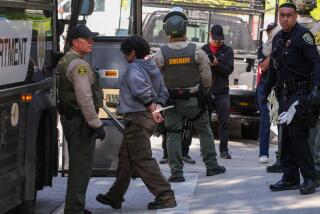LAPD again didn’t heed protocols, critics say
- Share via
As Mayor Antonio Villaraigosa returned to Los Angeles on Friday in hopes of quelling anger over the LAPD’s use of force at an immigration rally, he and other officials questioned why officers ignored rules established after a similar incident outside the 2000 Democratic National Convention.
The department ended up paying reporters and demonstrators more than $4 million for actions during the convention and agreed to a sweeping series of restrictions on how officers deal with large crowds.
“There were protocols that were supposed to happen in these kinds of situations,” Villaraigosa said. “Clearly, those protocols weren’t followed. We’ve got to ask why, who was responsible and what consequences there are for not following those protocols.”
The restrictions ban officers from using “less-than-lethal” weapons on individuals and crowds unless they are combative, require police to give protesters time to clear out of an area before force is used and establish “safe areas” where the media can operate without LAPD interference.
The department’s failure to adhere to the rules will be a major issue in what potentially could be dozens of lawsuits against the city, the first of which were filed Friday.
“Nothing that they agreed to happened,” said Carol Sobel, one of the civil rights attorneys who handled the lawsuit against the LAPD over the 2000 demonstration.
Police Chief William J. Bratton said he was concerned about history repeating itself. “It has many of the same elements that the DNC event had now seven years ago,” he said Thursday.
On Friday, after meeting with the mayor and other community leaders, Bratton continued to criticize the police actions, in which officers in riot gear fired foam bullets and used batons on demonstrators and reporters during the May Day immigrant rights march at MacArthur Park.
“A lot went wrong,” he said. “I’m embarrassed for this department.”
The LAPD and other police departments have been struggling for decades over how to handle demonstrations and other crowd-control situations.
The city paid $4.1 million to settle lawsuits claiming that Los Angeles police officers roughed up people during the 2000 convention.
More than 90 protesters, reporters and bystanders said their civil rights were violated when police opened fire with 200 rounds of beanbag munitions, stingers and hard rubber bullets after ordering demonstrators to disperse.
As part of the settlement, the LAPD agreed to reforms aimed at defusing tensions during protests. A key element was to give people time to move out themselves before police move in with force.
On Tuesday, officers came under attack with bottles and other objects from a group of agitators. Commanders decided to clear the park. Police issued a warning from a chopper, but officials have acknowledged that some people didn’t hear it.
Officers dressed in riot gear then moved in, pushing people back toward the park, hitting some with batons and firing 240 “less-than-lethal” projectiles.
Reporters and others seemed surprised and later said they had no warning.
Paul Hoffman, one of the attorneys who won the DNC settlement, agreed that the MacArthur Park actions violated the rules of engagement.
“They didn’t give people a chance to leave the area, which was exactly the problem at the DNC,” Hoffman said. “It’s ridiculous.”
The rules state that “less-lethal weapons should not be used against a person or crowd that is retreating unless the person or crowd continues to engage in unlawful activity that is aggressive and/or combative.”
Sobel said it appeared the department did not isolate from the crowd those who were throwing objects.
“They could have isolated them to the side, but instead they pushed them back into the park where the protesters and families were,” she said.
Though the court-mandated rules also require targeted use of weapons such as foam bullets, Sobel said videotapes appear to show officers firing indiscriminately at people in the park, including journalists.
The first legal claims were filed Friday. KTTV television news camerawoman Patti Ballaz alleged civil rights violations by the LAPD when she was hit with a baton. She said she suffered a fractured wrist and injuries to her ankle. Attorney Luis Carrillo filed suit on behalf of two protesters who say officers beat them.
Villaraigosa, who cut short a trip to Mexico, met Friday with Bratton and Assembly Speaker Fabian Nunez, county Supervisor Gloria Molina and other civic leaders.
“Those images hit me in the gut. What happened May 1 was wrong,” Villaraigosa said. “As mayor, I’m doing everything I can to make it right.”
Villaraigosa, who had been on a nine-day trade mission, initially decided to stick to his travel schedule because he did not want to cancel meetings with the presidents of El Salvador and Mexico.
But when he had dinner with Mexican President Felipe Calderon on Thursday night, much of the conversation focused on the MacArthur Park incident, a source said.
Villaraigosa also was getting pressure to return from leaders in Los Angeles who felt he should be here addressing the growing controversy.
patrick.mcgreevy@latimes.com
Contributing to this story were staff writers Tami Adbollah, Andrew Blankstein, Martha Groves and Richard Winton.
*
(BEGIN TEXT OF INFOBOX)
Rules of engagement
Here are three crowd-control rules the LAPD agreed to follow as part of a settlement of lawsuits filed by protesters and journalists who claimed their rights were violated during the 2000 Democratic National Convention:
* Give protesters a chance to move before using force to clear an area.
* Use “less-than-lethal” weapons only if protesters are aggressive or combative.
* Establish “safe zones” where reporters could cover protests without police interference.
Source: Times staff
More to Read
Sign up for Essential California
The most important California stories and recommendations in your inbox every morning.
You may occasionally receive promotional content from the Los Angeles Times.











